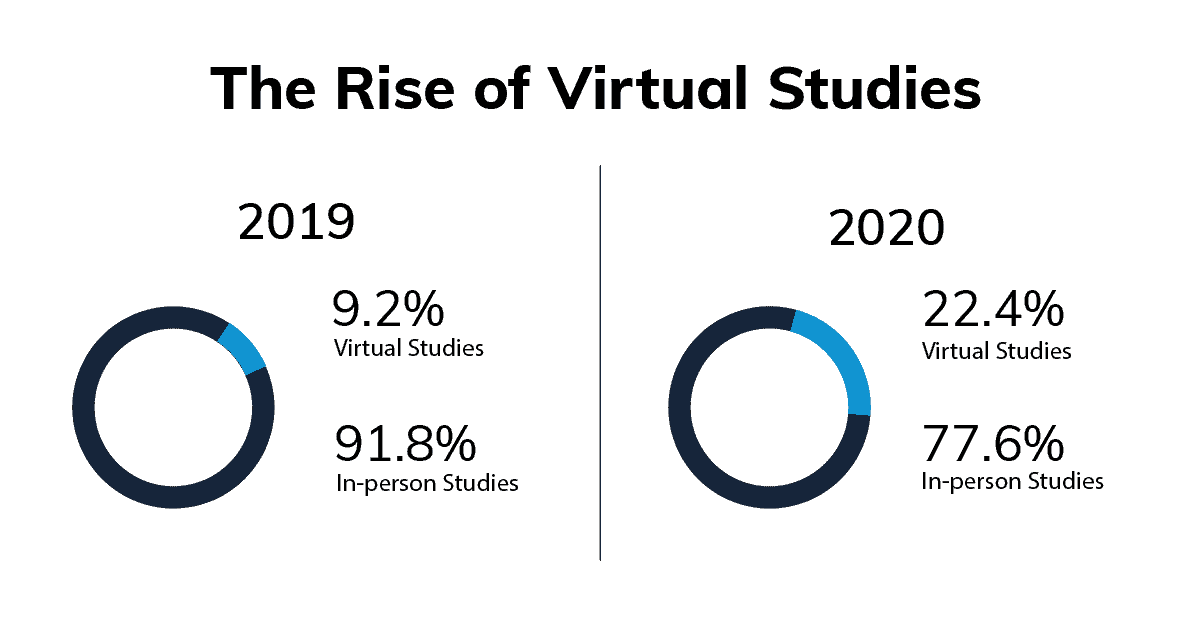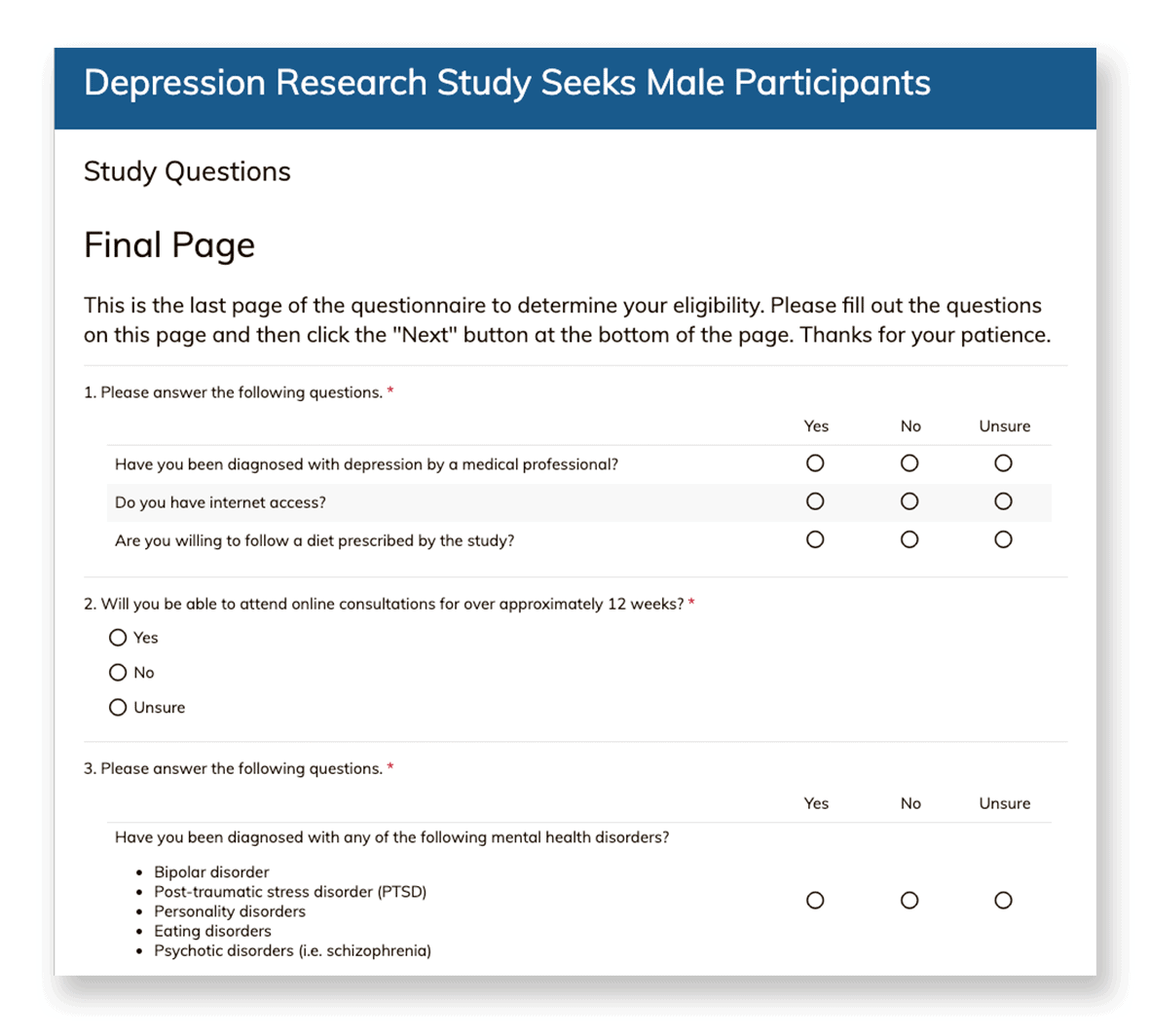The number of virtual studies has increased by 145% in 2020 due to the COVID-19 pandemic.
Virtual studies present a number of opportunities for improving participant recruitment, participant experience and collecting more robust data, but also provide challenges when it comes to participant retention.
In 2019, just 9.2% of studies were self-described as virtual and without in-person visits. In 2020 we’ve seen that number more than double to 22.4%.

This dataset comes from 363 studies we examined between the beginning of 2019 and November 1st, 2020.
For each study, we built a data-driven model of recruitment and enrollment, as part of our complimentary Due Diligence Analysis provided to studies seeking participant recruitment assistance.
The Impact of The Rise of Virtual Studies

A large increase in the number of studies being conducted virtually has a major impact on study design, participant recruitment, and creates challenges for retention.
One benefit of conducting a virtual study and removing in-person visits is that it can often be significantly easier to recruit, for two main reasons.
The first is that virtual studies reduce the burden of participation, due to the removal of in-person visits, which reduces participant time commitment and travel.
The second reason recruitment becomes easier is that for studies that don’t require in-person visits, you can target a much broader geographical area.
However, this makes retaining participants more difficult as there’s less of a relationship developed between researchers and participants due to a lack of in-person interaction.
Virtual studies also present an opportunity to recruit a more geographically diverse population, which can help to enroll a sample with more rural participants, participants from different ethnic or racial backgrounds, or from different socioeconomic backgrounds.
How to Make the Most of Recruitment for a Virtual Study
Enroll Participants More Cost-Effectively with Digital Advertising
Unlike traditional media advertising (e.g. newspaper, radio and TV advertising) which is naturally restricted by geography, digital advertising uses auction systems that can automatically target your advertising to locations with cheaper inventory, which translates into more cost-effective recruitment.
Make Your Research More Robust
Alternatively, recruiting from a larger geographic area via digital advertising could be used to recruit a larger number of participants for the same recruitment budget.
This provides an opportunity to increase your sample size and potentially improve the robustness of your research.
However it’s important to use data-driven modeling to understand what is a realistic enrollment goal for your study, taking into account your resources, timeframe, eligibility criteria and study design.
This is especially important for larger studies, as small errors or omissions with larger sample sizes have an outsized impact on your ability to recruit.
Recruit Participants Faster
Targeting a larger geographic area also enables you to advertise to more people simultaneously, which translates into being able to recruit more participants for your study faster.
Reduce Time Spent on Recruitment and Improve the Participant Experience
If you use comprehensive online screening and an automated or self-service virtual consent and enrollment process then you may be able to forego phone screening entirely.
 Trialfacts has developed desktop, mobile, and tablet-compatible software designed specifically for clinical trial patient prescreening.
Trialfacts has developed desktop, mobile, and tablet-compatible software designed specifically for clinical trial patient prescreening.
This significantly reduces the amount of time study teams need to spend on recruitment. It also allows for an improved participant experience, as a potential participant can go from seeing an ad or promotional post about your study, learn about it on the study website, decide they’re interested, sign up and proceed through online screening, consent and enroll into the study all in one go.
With these steps all being completed by most people in one sitting, the number of people dropping out at each step of enrollment is greatly reduced.
This means you don’t need to reach as many people in your target population to achieve the same number of enrolled participants as you otherwise would need to, which results in more cost-effective and faster enrollment.
Use Geography to Your Advantage to Increase Diversity
Virtual studies also present an opportunity to recruit a more geographically diverse population. Targeting different geographical areas can help to recruit more rural participants, participants from different ethnic or racial backgrounds, and from different socioeconomic backgrounds.
You can read more about meeting the challenges of diversity and inclusion in clinical research here, or see our guide on how to recruit a more representative sample.
How to Maximize Retention in a Virtual Study
Some of the resources saved in the recruitment process should be redirected into retention efforts, as drop-outs can be higher in virtual studies since typically there is less of a personal connection or relationship between participants and researchers.

Trialfacts phone screening appointment system both dramatically improves the successful contact rate, and significantly reduces the amount of time needed to contact referrals.
To combat this, put effort into communicating with participants frequently. For large studies, this may have to be on a 1-to-many basis. Using communication formats such as email, newsletters, and text messages (SMS, WhatsApp, Facebook Messenger) can work well. See our article on keeping participants engaged for the most relevant types of information participants are interested in.
If you have a smaller number of participants then 1-to-1 phone communication where you take the time to get to know participants and develop the participant-researcher relationship will work best.
If you’d like to have us build out a model of enrollment for your study, free of charge, complete the Recruitment Plan Request Form below.

